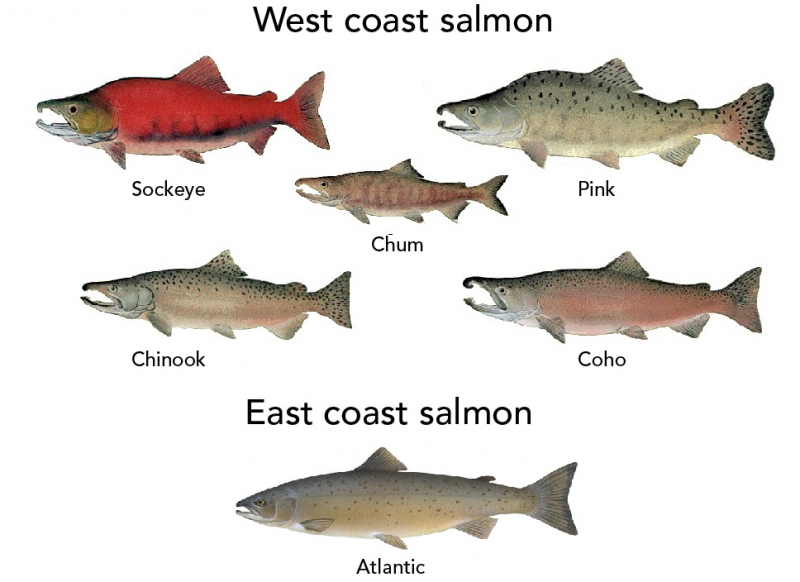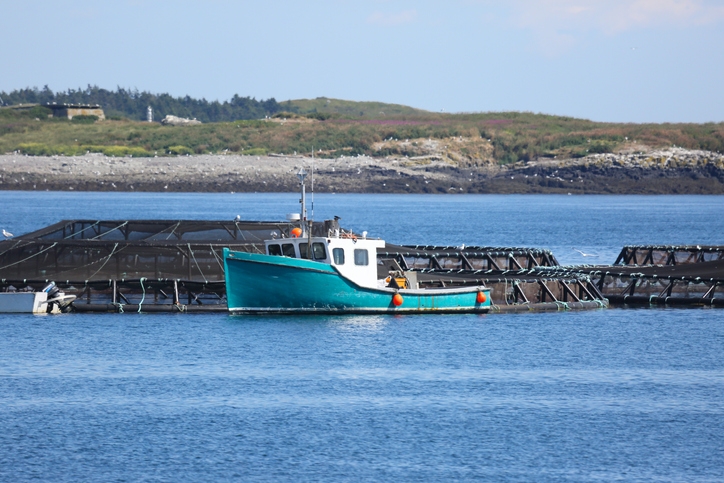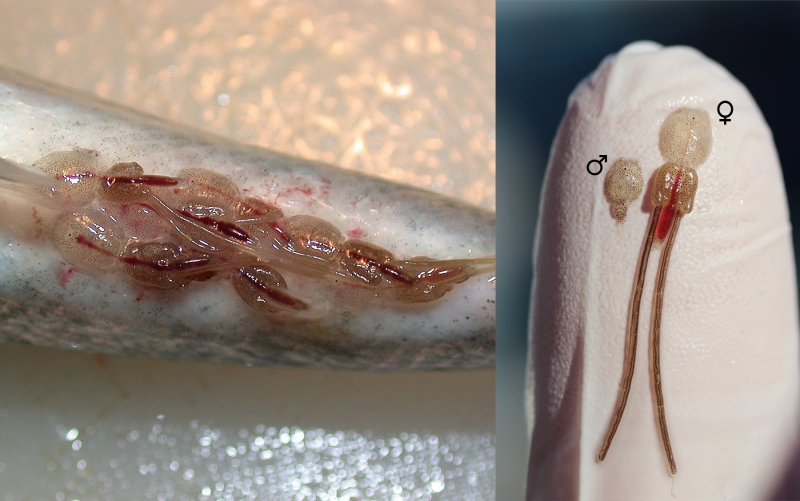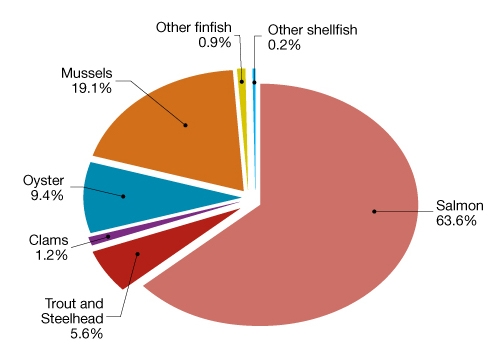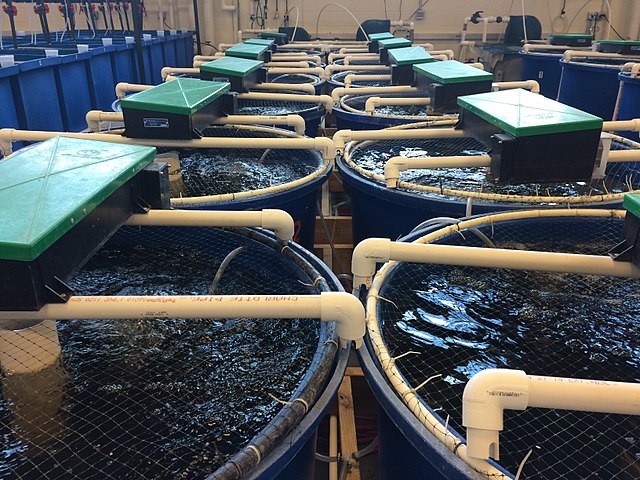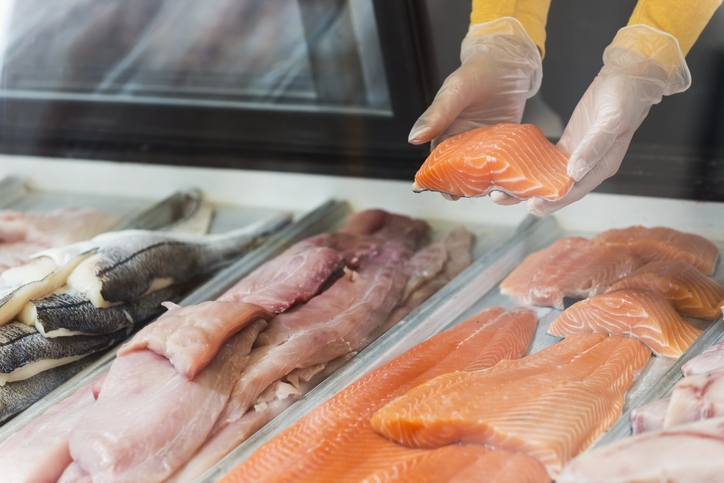Farmed Salmon vs. Wild Salmon
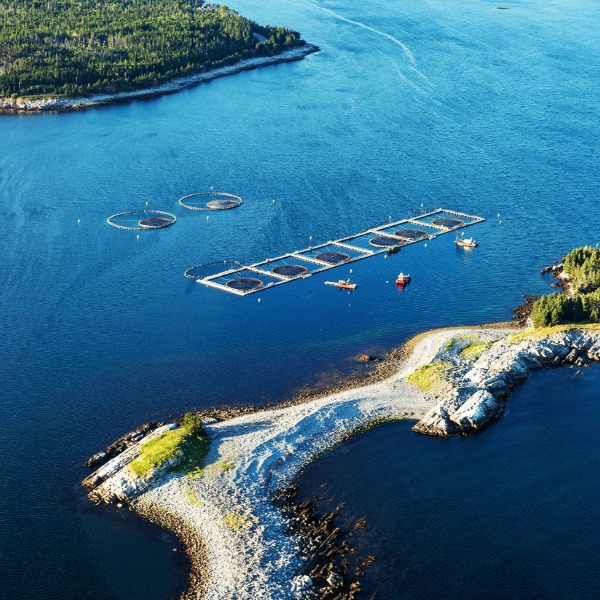
Salmon aquaculture pens (shaunl, iStockphoto)

Salmon aquaculture pens (shaunl, iStockphoto)
How does this align with my curriculum?
Aquaculture is seen as a sustainable way to produce fish. But are farmed salmon better than wild fish?
Do you eat salmon? If so, how do you like it? Do you barbeque it? Do you have it as sushi? Do you steam it with veggies?
If you’ve ever bought salmon from the grocery store, you might have noticed all kinds of information on the packaging. You might have seen the type of fish as Pacific or Atlantic salmon. Or you might notice it is labelled “farmed” or ''wild.” What does it even mean to farm fish? How does farming fish compare with farming other livestock on land? It is important to ask questions like this because the way that food is produced can affect the environment and our health.
Did you know?
Farming fish and other species that live in water is known as aquaculture.
Image - Text Version
Shown is a colour diagram of six species of salmon. Five are identified as West Coast salmon. These are Sockeye, Chum, Pink, Chinook, and Coho. One species is identified as an East Coast salmon. This is the Atlantic salmon. The west coast salmon have thick bodies and inwardly hooked mouths. They tend to be bluish gray with silver on their bellies, and have dark spots on their heads and backs. Some, like the Sockeye salmon, can have red or pinkish sides. The east coast salmon is similar, but it does not have a hooked mouth. It also has more of a tan, rather than a red, tinge on its sides.
Let’s learn about what a fish farm is. Then, we’ll discover some of the benefits fish farming can bring and some of the challenges. Finally, we’ll look at how to farm fish sustainably.
What does “farming” fish mean?
Image - Text Version
Shown is a colour photograph of a boat alongside net pens in the ocean. The blue and white fishing boat is in the centre of the frame. Nearby are several large cage-like net pens. The pens have about a metre of net sticking out of the top of the water.
A fish farm, also known as an aquaculture facility, is a large water-filled enclosure that humans control. In Canada, salmon farming typically either takes place in net pens in the ocean or tanks on land.
Net pens are cage-like structures made out of nets. They are located in open bodies of water, such as the ocean. There are different types of net pens based on their distance from the shore. Coastal or inshore net pens are located near the coast. Ocean or offshore net pens are located far from the coast.
Raising fish on land in tanks is known as land-based aquaculture. This is a lot like raising fish in swimming pools.
What are some of the challenges with farming salmon?
Farming salmon can produce millions of salmon that are used for food. But some people have concerns with farming practices.
Net pens can house thousands of salmon in a fairly small area. This means that the salmon live in a small space compared to in the wild. How small is small? In general, salmon farms keep the population density around 15 kg/m3. This is about the same as two adult salmon per cubic meter.
The density of populations is carefully studied to make sure that the fish have space to swim freely. People working with the fish also make sure that there is enough dissolved oxygen in the water for the fish to survive and do well. They also make sure that the fish and water quality are continuously monitored. Fish behaviour is also monitored to spot any sign of disease or distress.
However, when fish are close together, it is easier for parasites such as sea lice to spread among them. In the past, chemicals were used to treat lice. This can be harmful, especially for young fish. now use cleaner fish to control the sea lice.
Image - Text Version
Shown are two colour photographs of sea lice. On the left, about a dozen sea lice can be seen stuck to the belly of a salmon. The lice are a pale beige colour and have a wet, gelatinous appearance. Some have what look like reddish tails. On the right is a close-up of a male and a female sea louse on the tip of a finger wearing a white latex glove. The female sea louse looks like two gelatinous beige ovals connected together. The oval at the head end is about four times the size of the other oval. The male sea louse has a similar gelatinous head oval, but connected to it is a split oval that has three parts projecting out of it. The first looks like a short red tail. That is coming out of the centre of the split oval. On either side of this are two very long, brown cylindrical parts.
New technologies are also being studied to control sea lice in innovative ways. One example is putting the net pens in deeper waters, where the temperatures too low for sea lice development. New approaches such as these are good examples of methods that make aquaculture .
Concerns have also been raised that fish farms produce waste such as matter, uneaten food, and chemicals. This waste can concentrate under pens in shallow water and can affect the environment, including nearby wildlife. To address this concern, modern salmon farms are located in deeper water. This allows them to take advantage of the rising and falling tides. The tides create currents which transport wastes out to sea. In addition, aquaculturists use underwater cameras to monitor feeding. This helps cut down on food waste.
Did you know?
Careers in aquaculture include business managers, research scientists, technicians, policy advisors, scuba divers, waste management specialists, and many more!
There can also be problems if salmon escape from the net pens. Escaped fish compete for food with local wild fish. If the farmed fish have parasites or other diseases, they can spread to healthy wild fish populations.
Scientists are studying how escaped farm fish can survive in the wild. For example, they are looking into the impacts of when farmed salmon breed with wild salmon. They wonder if farmed salmon are as capable of surviving in the wild as wild salmon. More research needs to be done on this to find out if this is the case.
Salmon Farming and Human Health
Health professionals often recommend eating salmon instead of red meat, such as beef. They say salmon is healthier. But some people have concerns about eating farmed salmon. They believe that farmed salmon are less nutritious. This is not true. Farmed salmon are fed diets which are very similar to what they would eat in the wild. These diets are high in and . Studies about wild and fresh salmon have found that both are equally nutritious.
The meat of both farmed salmon and wild salmon, like most foods we eat, contains traces of harmful compounds such as polychlorinated biphenyls (PCBs). However, the levels in both farmed and wild salmon are well within the levels that are considered safe to eat. In fact, health authorities suggest eating oily fish like salmon several times per week as part of a healthy diet. This is because salmon, including farmed salmon, are excellent sources of omega-3 , as well as such as vitamin D, and .
Did you know?
By 2030, two thirds of the world’s fish is expected to come from aquaculture.
Salmon Farming in Canada
The Government of Canada reports that an average of 122 300 tonnes of farmed salmon was produced from 2011 to 2015. British Columbia produced 60% of this. Other important salmon-producers include Newfoundland and Labrador and New Brunswick.
However, aquaculture is more than fish farming. Many are produced commercially in Canada, as you can see in the diagram below.
Image - Text Version
Shown is a colour pie chart of Canadian aquaculture production in 2014. Salmon has 63.6% of the market. Its segment is coloured pink. Mussels have 19.1% of the market. Its segment is coloured orange. Oysters have 9.4% of the market. Its segment is coloured medium blue.Trout and Steelhead has 5.6% of the market. Its segment is coloured red. Clams have 1.2% of the market. Its segment is coloured purple. Other fish with fins have 0.9% of the market. Its segment is coloured yellow. Other shellfish have 0.2% of the market. Its segment is coloured pale blue.
How can we farm fish sustainably?
How can we keep farming fish while making sure we have the least impact on the environment? In other words, how can we have aquaculture? Scientists and fish farming companies around the world have been working tirelessly to find solutions. In Canada, the aquaculture industry has already made significant changes to address health and environmental concerns. In addition, they continue to conduct research and respond to the public’s concerns.
Did you know?
Scientists studying the environmental impacts of meat production found that cattle can produce about 20 times more greenhouse gases than farmed salmon. This difference does not apply to all types of aquaculture. Farming catfish had the same impacts as farming beef.
One way to make salmon farming more sustainable is to do more land-based aquaculture. This form of fish farming is seen as less threatening to sea life than ocean or coastal net pens. But it can be more expensive to do.
For example, a recirculating aquaculture system is essentially a large, complicated aquarium.
Image - Text Version
Shown is a colour photograph of recirculating aquaculture pens. The pens are in a large industrial space. 12 pens in two columns of six are visible. Each of the pens is a circular pool covered by a net. Beige tubes and black plastic boxes sit atop a central post in each of the pens.
These systems come with some costs that net pens don’t. For example, they need heating, electricity, and lots of human staff. This increases their Another concern of land-based aquaculture relates to the treatment of the fish. Because environmental conditions can be closely controlled, the population density of fish can be much higher. This can result in very cramped conditions. Current land-based systems often have population densities closer to 100 kg/m3 as compared to 15 kg/m3 in net pens. It has also been noted that land-based aquaculture uses a lot of freshwater. This might take water away from local plants, animals and people.
Another possibility being investigated is to grow fish in giant offshore aquapods. An is a large, spherical cage that is suspended in the ocean. Aquapods can also be free-floating. The pods are connected to a boat with workers and a supply of food for the fish. The thinking is that, since aquapod systems are further removed from the coastline, they are exposed to wind, waves and ocean currents. As a result, any wastes produced will fall into deeper water or be more spread out. Since the free-floating aquapods drift on the ocean currents, they would always be moving to new stretches of ocean.
The Future of Fish on Your Plate
Regardless of whether it is carried out on land or in the sea, food production systems can potentially harm the environment if not done properly. This is why these concerns are addressed by scientific research, governments, and industry. With years of experience and research, sustainable aquaculture is now a reality. Taking better care of the fish today will enable us to take better care of ourselves tomorrow.
It is in everyone’s best interest that we work to produce the best aquaculture products in Canada. This industry is important because it offers sustainable food products for your table. It has also allowed fishing communities to survive as net-based commercial fishing became impossible. Today there are almost 60 million people working in the aquaculture industry around the world, and that number will continue to grow.
According to the United Nations, fish are an important source of protein, vitamins, and minerals for people worldwide. Farmed fish have the potential to feed billions of people. After all, the world’s population is growing. Fishing in the wild can’t keep up with the demand of feeding all these people! Eventually, fish farming might be our only option. That’s why it’s important to do it sustainably.
Image - Text Version
Shown is a colour photograph of a fish counter at a grocery store. Several types of filleted fish are visible. An employee wearing latex gloves holds a salmon piece above a display of salmon fillets and cuts.
How can you choose better options when buying groceries? Look for products with certifications from sustainable fisheries organizations. These certification logos identify the companies who follow best practices for our health and the environment.
Starting Points
- Does your family like to eat salmon? Do you know how the salmon you eat was produced?
- Do you think the benefit of adding more fish protein to your diet outweighs the potential risks associated with eating farmed fish? Explain.
- How could fish farming help with global food sustainability?
- Why is there room for growth in fish farming in Canada?
- How might economics influence the type of fish farming that is practiced in an area? What other factors can influence fish farming practices?
- What are the two common types of fish farming?
- Identify at least three concerns about fish farming
- Why is there concern about PCBs in farmed fish?
- What solutions are possible for improving the water conditions for farming fish?
- Is farming fish a totally new practice? What aspects of modern fish farming rely on modern techniques and technologies?
- Have you seen any news reports or documentaries about fish farming? Did the report or documentary appear biased? That is, did the documentary focus solely on either the negative impacts of fish farming or the benefits of fish farming? Was the report or documentary unbiased? Why or why not?
- This article can be used to support teaching and learning in Biology, Health and Environmental Science related to aquaculture, fisheries and sustainability. Concepts introduced include fish farm, coastal or inshore aquacultures, ocean or offshore aquacultures, polychlorinated biphenyls (PCBs), sustainable, land-based aquaculture, recirculating aquaculture system and aquapods.
- After reading this article, to help students consolidate learning, teachers could have students consider the positive and negative aspects of fish farming using a Pros & Cons Organizer learning strategy. Ready-to-use Pros & Cons reproducibles are available in [Google doc] and [.pdf] formats.
- To go further, teachers could have students look at the impacts of starting a new net pen fish farming operation in a coastal community in Canada from the perspective of a variety of stakeholders, using an Issues & Stakeholders learning strategy. Ready-to-use Issues & Stakeholders reproducibles are available in [Google doc] and [.pdf] formats.
Connecting and Relating
- Does your family like to eat salmon? Do you know how the salmon you eat was produced?
- Do you think the benefit of adding more fish protein to your diet outweighs the potential risks associated with eating farmed fish? Explain.
Relating Science and Technology to Society and the Environment
- How could fish farming help with global food sustainability?
- Why is there room for growth in fish farming in Canada?
- How might economics influence the type of fish farming that is practiced in an area? What other factors can influence fish farming practices?
Exploring Concepts
- What are the two common types of fish farming?
- Identify at least three concerns about fish farming
- Why is there concern about PCBs in farmed fish?
- What solutions are possible for improving the water conditions for farming fish?
Nature of Science/Nature of Technology
- Is farming fish a totally new practice? What aspects of modern fish farming rely on modern techniques and technologies?
Media Literacy
- Have you seen any news reports or documentaries about fish farming? Did the report or documentary appear biased? That is, did the documentary focus solely on either the negative impacts of fish farming or the benefits of fish farming? Was the report or documentary unbiased? Why or why not?
Teaching Suggestions
- This article can be used to support teaching and learning in Biology, Health and Environmental Science related to aquaculture, fisheries and sustainability. Concepts introduced include fish farm, coastal or inshore aquacultures, ocean or offshore aquacultures, polychlorinated biphenyls (PCBs), sustainable, land-based aquaculture, recirculating aquaculture system and aquapods.
- After reading this article, to help students consolidate learning, teachers could have students consider the positive and negative aspects of fish farming using a Pros & Cons Organizer learning strategy. Ready-to-use Pros & Cons reproducibles are available in [Google doc] and [.pdf] formats.
- To go further, teachers could have students look at the impacts of starting a new net pen fish farming operation in a coastal community in Canada from the perspective of a variety of stakeholders, using an Issues & Stakeholders learning strategy. Ready-to-use Issues & Stakeholders reproducibles are available in [Google doc] and [.pdf] formats.
Learn more
What is aquaculture and why do we need it? (2019)
This video (3:06 min.) by the Global Aquaculture Alliance explains the range of the aquaculture industry.
Aquaculture in Atlantic Canada - Atlantic Salmon
This factsheet by the Government of Canada has information on the salmon farming industry in Atlantic Canada.
The Velella Mariculture Research Project (2011)
This video (6:19 min.) by the Velella Project presents how they use offshore aquapods for more sustainable fish farming.
The Future of Food: The Rise of the Sea (2017)
This video conference (18:16 min.) by Steve Gaines discusses the sustainability of fisheries in the present and future.
The State of the World Fisheries and Aquaculture (2020)
This interactive story about global aquaculture from the Food and Agriculture Organization of the United Nations contains a lot of information, as well as data displayed as statistics and graphs.
Aquaculture can feed the world, new report claims (2017)
This article by Nicki Holmyard discusses a University of California report that suggests that aquaculture may be the solution to global food shortages
How Seafood is Farmed: Net Pens (2013)
This video (1:34 min.) explains the problems and potential solutions of net pens for aquaculture.
References
American Heart Association News (2018). Eating fish twice a week reduces heart stroke risk. Accessed at https://www.heart.org/en/news/2018/05/25/eating-fish-twice-a-week-reduces-heart-stroke-risk
Colombo S.M. & Mazal X. (2020). Investigation of the nutritional composition of different types of salmon available to Canadian consumers. Journal of Agriculture and Food Research, Vol.2 (December 2020). DOI: 100056
Davidson, J., May, T., Good, C., Waldrop, T., Kenney, B., Terjesen, B. F., and Summerfelt, S. (2016). Production of market-size North American strain Atlantic salmon Salmo salar in a land-based recirculation aquaculture system using freshwater. Aquacultural Engineering. Volume 74. Accessed at https://www.sciencedirect.com/science/article/pii/S014486091530042X
Green, D. M., Penman, D. J., Migaud, H., Bron, J. E., Taggart, J. B., & McAndrew, B. J. (2012). The impact of escaped farmed Atlantic salmon (Salmo salar L.) on catch statistics in Scotland. PLoS One, 7(9). DOI: 10.1371/journal.pone.0043560
FAO (n.d.). National Aquaculture Overview – Canada. Food and Agriculture Organization of the United Nations. Accessed at http://www.fao.org/fishery/countrysector/naso_canada/en#History_and_general_overview
Food and Agriculture Organization of the United Nations. (2019). 2018 The State of the World Fisheries and Aquaculture. Retrieved from http://www.fao.org/state-of-fisheries-aquaculture
Friesen, E.N., Ikonomou, M.G., Higgs, D.A., Ang, K.P., and Dubetz, C. (2008). Environmental Science & Technology. 42(10), 3519-3523 Accessed at https://pubs.acs.org/action/showCitFormats?doi=10.1021%2Fes0714843&href=/doi/10.1021%2Fes0714843
Gephart, J.A., Golden, C.D., Asche, F., Belton, B., Brugere, C. and Froehlich, H.E. (2020). Scenarios for global aquaculture and its role in human nutrition. Reviews in Fishery Science & Aquaculture. 29(1) 122-138. Accessed at https://www.tandfonline.com/doi/full/10.1080/23308249.2020.1782342
Government of Canada. (2017, March 15). Farmed Salmon. Retrieved from https://www.dfo-mpo.gc.ca/aquaculture/sector-secteur/species-especes/salmon-saumon-eng.htm
Government of Canada. (2019, January 25). Managing organic wastes. Retrieved from http://www.dfo-mpo.gc.ca/aquaculture/protect-protege/waste-dechets-eng.html
Green, D. M., Penman, D. J., Migaud, H., Bron, J. E., Taggart, J. B., & McAndrew, B. J. (n.d.). The impact of escaped farmed Atlantic salmon (Salmo salar L.) on catch statistics in Scotland. Retrieved from https://www.ncbi.nlm.nih.gov/pmc/articles/PMC3435321/
Lundebye, A.K., Lock, E.J., Rasinger, J.D., Nøstbakken, O.J., Hannisdal, R., Karlsbakk, E., Wennevik, V., Madhun, A.S., Madsen, L., Graff, I.E., Ørnsrud, R. (2017). Lower levels of Persistent Organic Pollutants, metals and the marine omega 3-fatty acid DHA in farmed compared to wild Atlantic salmon (Salmo salar). Environmental Research. Volume 155:49-59. Accessed at https://www.sciencedirect.com/science/article/abs/pii/S0013935116311811?via%3Dihub
Konstantinovsky, M. (2019, January 11). Is Farmed Salmon Bad for You? Retrieved from https://www.onemedical.com/blog/eat-well/farmed-salmon
Page S.H. (2013) Aquapod Systems for Sustainable Ocean Aquaculture. In: Christou P., Savin R., Costa-Pierce B.A., Misztal I., Whitelaw C.B.A. (eds) Sustainable Food Production. Springer, New York, NY. https://doi.org/10.1007/978-1-4614-5797-8_187
Rosenberg, A. (2017). Can farmed fish feed the world sustainably? Accessed at https://www.universityofcalifornia.edu/news/can-farmed-fish-feed-world-sustainably
Searchinger, T., Waite, R., Hanson, C., Ranganathan, J., Dumas, P., & Matthews, E. (2018, December). Creating a Sustainable Food Future. Retrieved from https://www.wri.org/publication/creating-sustainable-food-future
Smart, A. (2017, December 3). Are land-based fish farms a financially viable option? Retrieved from https://www.timescolonist.com/islander/are-land-based-fish-farms-a-financially-viable-option-1.23111387
